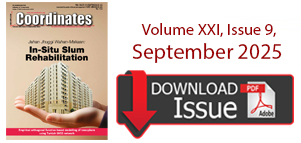| His Coordinates | |
“We understand the nuances of the workflows in markets”
 |
|
Please give us an idea about the structure of Trimble Geospatial Division. What are the broad categories under which it is classified?
The Geospatial Division includes a diverse set of solutions for geospatial data capture and analysis. The solutions range from all types of GNSS devices to total stations and laser scanners, from mobile imaging solutions to aerial cameras, from imagery analysis software to field data collection software, as well as office software for processing and deliverable creation. We have been, and remain, focused on the survey professional as well as GIS professionals but recognize and embrace the fact that geospatial data is playing a more prominent role in many occupations.
How do you approach developing countries vis-avis developed countries while marketing your products?
Regardless of geography and market, we always focus on how users can benefit from using our systems. This requires that we understand the nuances of the workflows in markets and geographies we serve and deliver solutions that support and enhance those workflows. We achieve this through close collaboration with our local partners and distribution as well as working directly with endusers. Within developing countries, in some cases we have opportunity to help user develop and define the workflows in ways that may not exist in the developed countries. This is always exciting.
What role do you see of convergence of various technologies in the geospatial domain for the growth of geospatial market?
The convergence of technology will always drive disruption in the market. Being able to determine how to best leverage that disruption will help determine where there is opportunity for growth. There is also increased risk for those that do not embrace the convergence. The potentially most important convergence the domain faces is the capability and function of consumer devices and ‘nonprofessional’ tools into the market.
What is your view on UAV/ UAS future trends?
UAS is going to be a critical component of business going forward, and this is true for the geospatial market. Regulations will continue to be an issue in the near future but forward thinkers will continue to leverage the technology. Specifically within the geospatial market, there will be continued emphasis on how to rapidly leverage the data that is created from UAS. The flexibility of the flight systems will only be valuable if the tools used to get to a decision keep up.
Government of India have initiated a program called, ‘Make in India’. Do you see Trimble taking advantage of the same in any way?
This represents an opportunity and we already have some production in country. We will continue to evaluate how to best capture the opportunity while balancing the global business.
How does Trimble align itself with its products and services to support Government of India’s programmes like Smart Cities and Digital India?
Trimble has many different solutions that support programs such as Smart Cities and Digital India. We believe the breadth of our portfolio positions us well to help realize the promise of Smart Cities and Digital India. Our experience and capabilities in supporting such initiatives in other parts of the world will keep us in good stead in appropriately supporting these programs in India.
How has been the growth in business opportunities in the SAARC region compared to India?
The region is important for Trimble and India sets the pace for growth.













 (8 votes, average: 1.38 out of 5)
(8 votes, average: 1.38 out of 5)





Leave your response!